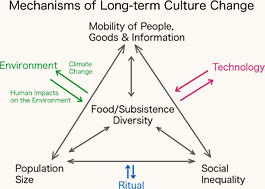Archaeological, historical, and paleoenvironmental studies will be used to test project hypotheses.
Correlations between subsistence/food diversity and the scale of production, community size, and other key factors (see Figure) will be examined.

Correlations between subsistence/food diversity and the scale of production, community size, and other key factors (see Figure) will be examined.

This team has analyzed various lines of Jomon archaeological data from northeastern Japan, including faunal/floral data and lithic assemblage data. Chemical and biological studies of archaeological remains, including stable isotope analysis of human skeletal remains, residue analysis of pottery, and AMS dating, were also conducted.
Early and Middle Jomon site database for Aomori Prefecture is also being built, which can be used to update the estimate of Jomon population size and to examine the correlation between community size and its resilience. Climate change is taken into consideration as a key factor to understand mechanisms of long-term culture change. Pollen analysis and alkenon sea surface temperature analysis are in progress to identify the natures and timings of mid-Holocene climate change.
In California, Prof. Kent Lightfoot and his collaborators have started analyses of faunal and floral remains and settlement data obtained from the Año Nuevo State Park. Preliminary results of their analyses indicate an increased biodiversity and a higher level of sustainability from the late Holocene to the historic period. As for the Northwest Coast of North America, lithic assemblage data and faunal/floral data from the Lower Columbia River are being analyzed to understand the characteristics of subsistence and settlement system by Prof. Ken Ames and his colleagues. Demographic simulations based on settlement date are also in progress. Other case studies in this team include those from the Gulf Islands,Canadian arctic, the Kurils/eastern Hokkaido, and Lake Baikal.